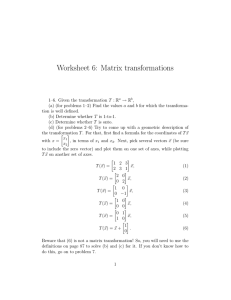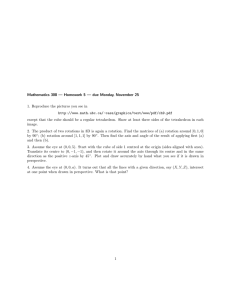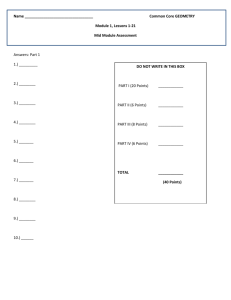Mathematics 308 — Geometry Chapter 8. Rigid transformations
advertisement
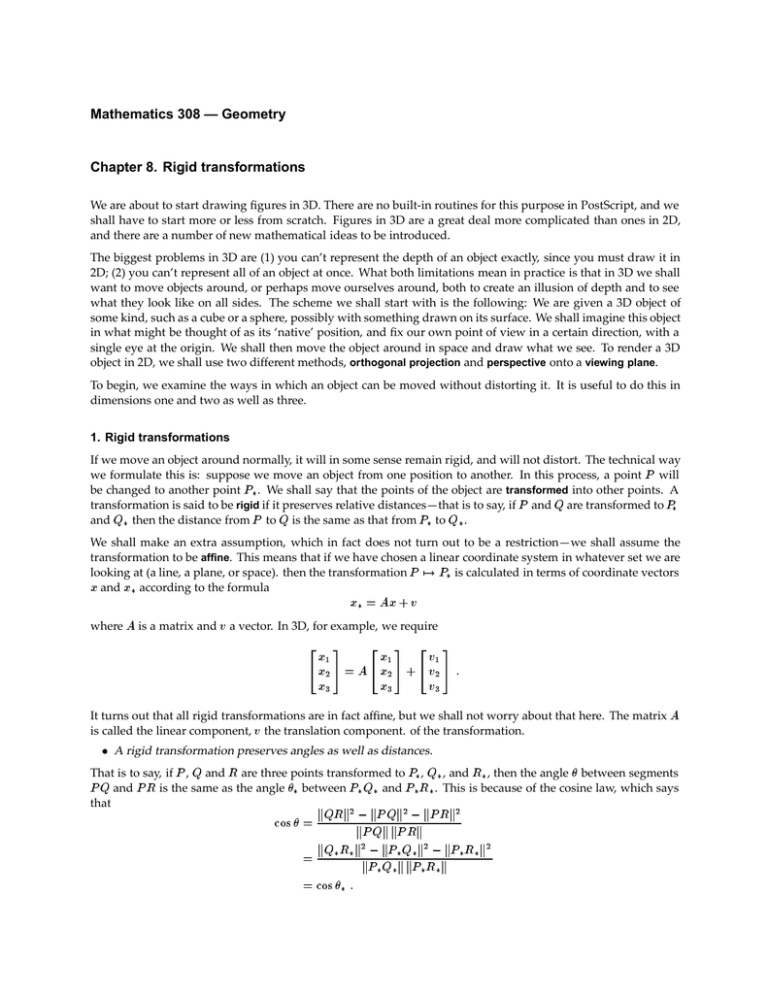
Mathematics 308 — Geometry Chapter 8. Rigid transformations We are about to start drawing figures in 3D. There are no built-in routines for this purpose in PostScript, and we shall have to start more or less from scratch. Figures in 3D are a great deal more complicated than ones in 2D, and there are a number of new mathematical ideas to be introduced. The biggest problems in 3D are (1) you can’t represent the depth of an object exactly, since you must draw it in 2D; (2) you can’t represent all of an object at once. What both limitations mean in practice is that in 3D we shall want to move objects around, or perhaps move ourselves around, both to create an illusion of depth and to see what they look like on all sides. The scheme we shall start with is the following: We are given a 3D object of some kind, such as a cube or a sphere, possibly with something drawn on its surface. We shall imagine this object in what might be thought of as its ‘native’ position, and fix our own point of view in a certain direction, with a single eye at the origin. We shall then move the object around in space and draw what we see. To render a 3D object in 2D, we shall use two different methods, orthogonal projection and perspective onto a viewing plane. To begin, we examine the ways in which an object can be moved without distorting it. It is useful to do this in dimensions one and two as well as three. 1. Rigid transformations If we move an object around normally, it will in some sense remain rigid, and will not distort. The technical way we formulate this is: suppose we move an object from one position to another. In this process, a point P will be changed to another point P . We shall say that the points of the object are transformed into other points. A transformation is said to be rigid if it preserves relative distances—that is to say, if P and Q are transformed to P and Q then the distance from P to Q is the same as that from P to Q . We shall make an extra assumption, which in fact does not turn out to be a restriction—we shall assume the transformation to be affine. This means that if we have chosen a linear coordinate system in whatever set we are P is calculated in terms of coordinate vectors looking at (a line, a plane, or space). then the transformation P x and x according to the formula 7! x = Ax + v where A is a matrix and v a vector. In 3D, for example, we require x1 x1 v1 4x 5 = A4x 5 + 4v 5 : 2 2 2 x3 x3 v3 2 3 2 3 2 3 It turns out that all rigid transformations are in fact affine, but we shall not worry about that here. The matrix A is called the linear component, v the translation component. of the transformation. A rigid transformation preserves angles as well as distances. That is to say, if P , Q and R are three points transformed to P , Q , and R , then the angle between segments PQ and PR is the same as the angle between PQ and PR. This is because of the cosine law, which says that 2 kPQk2 , kPRk2 cos = kQRk k,PQ k kPRk 2 2 2 = kQRk kP, kQPkQkPk R,kkPRk = cos : Rigid transformations 2 A few other facts are more elementary: The composition of rigid transformations is rigid. The inverse of a rigid transformations is rigid. In the second statement, it is implicit that a rigid transformation has an inverse. It will if its linear component does. But if its linear component does not have an inverse, then it must collapse several points onto one, a contradiction. An affine transformation is rigid if and only if its linear component is, since translation certainly doesn’t affect relative distances. In order to classify rigid transformations, we must thus classify the linear ones. Exercise 1.1. The inverse of the transformation components? x 7! Ax + v is also affine. What are its linear and translation 2. Dot and cross products A bit later we shall need to know some basic facts about vector algebra. In any number of dimensions we define the dot product of two vectors u = (x1; x2 : : : ; x ); v = (y1; y2 ; : : : ; y ) n to be n u v = x1y1 + x2y2 + x y : n n The relation between dot products and geometry is expressed by the cosine rule for triangles, which asserts that if is the angle between u and v then cos = kuuk kvvk : In particular u and v are perpendicular when u v In 3D there is another kind of product. If = 0. u = (x1; x2 ; x3 ); v = (y1 ; y2 ; y3 ) v is the vector (x2y3 , y2 x3 ; x3 y1 , x1 y3 ; x1 y2 , x2y1 ) : This formula can be remembered if we write the vectors u and v in a 2 3 matrix x1 x2 x3 y1 y2 y3 and then for each column of this matrix calculate the determinant of the 2 2 matrix we get by crossing out in then their cross product u turn each of the columns. The only tricky part is that with the middle coefficient we must reverse sign. Thus uv = Here x2 x3 ; , x1 x3 ; x1 x2 ; : y2 y3 y1 y3 y1 y2 a b = ad , bc : c d The geometrical significance of the cross product is contained in these rules: The length of w = u v is the area of the parallelogram spanned in space by u and v. Rigid transformations 3 It lies in the line perpendicular to the plane containing u and v and its direction is determined by the right hand rule. uv v u The cross product u v will vanish only when u and v are multiples of one another. In these notes, the main use of dot products and cross products will be in calculating various projections and related things. (1) Suppose to be any vector in space and u some other vector in space. The projection of u along is the vector u0 we get by projecting u perpendicularly onto the line through . What is this projection? It must be a multiple of . We can figure out what multiple by using trigonometry. We know three facts: (a) The angle between and u is determined by the formula cos = kuk kuk : Rigid transformations 4 kk (b) The length of the vector u0 is u cos , and this is to be interpreted algebraically in the sense that if u0 faces in the direction opposite to this is negative. (c) Its direction is either the same or opposite to . The vector = is a vector of unit length pointing in the same direction as . Therefore k k u0 = kuk cos kk = kuk kuk kuk kk = kuk2 = u : (2) Now let be the plane passing through the origin perpendicular to , and let u? be the projection of u onto . The vector u has the orthogonal decomposition u = u0 + u? and therefore we can calculate u? = u , u0 : (3) Finally, let u be the vector in we get by rotating u by 90 in , using the right hand rule to determine what direction of rotation is positive. How do we calculate u ? We want it to be perpendicular to both and u?, so it ought to be related to the cross product u?. A little thought should convince you that in fact the direction of u will be the same as that of u?, so that u will be a positive multiple of u?. We want u to have the same length as u?. Since and u? are perpendicular to each other, the length of the cross product is equal to the product of the lengths of and u?, and we must divide by to get a vector of length u?. Therefore, all in all k k k u = kk u? : Incidentally, in all of this discussion it is only the direction of that plays a role. It is often useful to normalize right at the beginning of these calculations, that is to say replace by = . k k Rigid transformations 5 u u u Exercise 2.1. Write PostScript programs to calculate dot products, cross products, 0 , ?, . 3. The classification of linear rigid transformations Let A be an n n matrix. a1 1 a1 2 : : : a1 a2 2 : : : a2 6 a2 1 A=4 ::: a 1 a 2 ::: a 2 ; ; ;n ; ; ;n n; n; n;n 3 7 5 : Let ei be the column vector with exactly one non-zero coordinate equal to 1 in the i-th place. Then Aei is equal to the i-th column of A. The transformation corresponding to A takes the origin to itself, and the length of ei is 1. Therefore the length of the i-th column of A is also 1. The angle between ei and ej is 90 if i 90. 6= j , and therefore the angle between the i-th and j -th columns of A is also Since the square of the length of a vector u is equal to the dot product u u, and the angle between two vectors of length 1 is given by their dot product u v , this means that the columns ui of A satisfy the relations n i=j u u = 10 otherwise i j Any matrix A satisfying these conditions is said to be orthogonal. The transpose tA of a matrix A has as its rows the columns of A. By definition of the matrix product tA A, its entries are the various dot products of the columns of A with the rows of tA. Therefore a matrix A is orthogonal if and only if AA = I : t If A and B are two n n matrices, then det(AB) = det(A) det(B) : The determinant of A is the same as that of its transpose. If A is an orthogonal matrix, then det(I) = det(A) det( A) = det(A)2 t so that det(A) = 1. If det(A) = 1, A is said to preserve orientation, otherwise reverse orientation. There is a serious qualitative difference between the two types. If we start with an object in one position and move it continuously, then the transformation describing its motion will be a continuous family of rigid transformations. The linear component at the beginning is the identity matrix, with determinant 1. Since the family varies continuously, the linear component can never change the sign of its determinant, and must therefore always be orientation preserving. A way to change orientation would be to reflect the object, as if in a mirror. 4. Orthogonal transformations in 2D In 2D the classification of orthogonal transformations is very simple. First of all, we can rotate an object through some angle (possibly 0 ). Rigid transformations 6 This preserves orientation. The matrix of this transformation is, as we saw much earlier, cos , sin : sin cos Second, we can reflect things in an arbitrary line. That is to say, given a line `, we can transform points on ` into themselves, points in the line through the origin perpendicular to ` into their negatives. This reverses orientation. Exercise 4.1. If ` is the line at angle with respect to the positive x-axis, what is the matrix of this reflection? It turns out there are no more possibilities. Every linear rigid transformation in 2D is either a rotation or a reflection. Let e1 = (1; 0), e2 = (0; 1), and let T be a linear rigid transformation. Since e1 and e2 both have length 1, both Te1 and Te1 also have length 1. All of these lie on the unit circle. Since the angle between e1 and e2 is 90, so is that between Te1 and Te2 . There are two distinct possibilities, however. Either we rotate in the positive direction from Te1 to Te2 , or in the negative direction. Rigid transformations 7 In the first case, we obtain Te1 and Te2 from e1 and e2 by a rotation. In the second case, something more complicated is going on. Here, as we move a vector u from e1 towards e2 and all the way around again to e1 , Tu moves along the arc from Te1 to Te2 all the way around again to Te1 , and in the opposite direction. Now if we start with two points anywhere on the unit circle and move them around in opposite directions, sooner or later they will meet. At that point we have Tu = u. Since T fixes u it fixes the line through u, hence takes points on the line through the origin perpendicular to it into itself. It cannot fix the points on that line, so it must negate them. In other words, T amounts to reflection in the line through u. u to be either of the points half way between e1 and Te1 . Exercise 4.3. Find a formula for the reflection of v in the line through u. Exercise 4.2. Explain why we can take 5. Rigid motions in 3D There is one natural way to construct rigid linear motions in 3D. Choose an axis, and choose on it a direction. Equivalently choose a unit vector u, and the axis to be the line through u, with direction that of u. Choose an angle . Rotate things around the axis through angle , in the positive direction as seen along the axis from the positive direction. Every orientation preserving linear rigid transformation in 3D amounts to rotation around some axis. The proof of this requires the notions of eigenvalue and eigenvector. If T is any linear operator, an eigenvector of T is a vector v 6= 0 such that Tv is a scalar multiple of v: Tv = cv : the number c is called the eigenvalue corresponding to v . Rigid transformations 8 If A is a matrix representing T , then the eigenvalues of T are the roots of the characteristic polynomial where x is a variable. For a 3 3 matrix det(A , xI) a1 1 , x a1 2 a1 3 A , xI = 4 a2 1 a2 2 , x a2 3 5 a3 1 a3 2 a3 3 , x 2 3 ; ; ; ; ; ; ; ; ; and the characteristic polynomial is a cubic polynomial which starts out ,x3 + : jj jj For x < 0 and x large, this expression is positive, and for x > 0 and x large it is negative. It must cross the x-axis somewhere, which means that it must have at least one real root. Therefore A has at least one real eigenvalue. In 2D this argument fails—there may be two conjugate complex eigenvalues instead. kTvk = kvk, or k k kk k k j jk k k k 6 j j If c = 1, then we have a vector fixed by T . Since T preserves angles, it takes all vectors in the plane through the origin perpendicular to v into itself. Since T reserves orientation and Tv = v , the restriction of T on this plane also preserves orientation. Therefore T rotates vectors in this plane, and must be a rotation around the axis through v . If c = ,1, then we have Tv = ,v . The transformation T still takes the complementary plane into itself. Since T preserves orientation in 3D but reverses orientation on the line through v , T reverses orientation on this plane. But then T must be a reflection on this plane. We can find u such that Tu = u, and w perpendicular to u and v such that Tw = ,w. In this case, T is rotation through 180 around the axis through u. Let c be a real eigenvalue of T , v a corresponding eigenvector. Since T is a rigid transformation, cv = v . Since cv = c v and v = 0, c = 1 and c = 1. 6. How axial rotations act To begin this section, I remark again that to determine an axial rotation we must specify not only an axis but a direction on that axis. This is because the sign of a rotation in 3D is only determined if we know whether it is assigned by a left hand or right hand rule. At any rate if choosing a vector along an axis fixes a direction on it. Given a direction on an axis we shall adopt the convention that the direction of positive rotation follows the right hand rule. 6 So now the question we want to answer is this: Given a vector = 0 and an angle . If u is any vector in space and we rotate u around the axis through by , what new point v do we get? This is one of the main calculations we will make to draw moved or moving objects in 3D . There are some cases which are simple. If u lies on the axis, it is fixed by the rotation. If it lies on the plane perpendicular to it is rotated by in that plane (with the direction of positive rotation determined by the right hand rule). If u is an arbitrary vector, we express it as a sum of two vectors, one along the axis and one perpendicular to it, and then use linearity to find the effect of the rotation on it. To be precise, let R be the rotation we are considering. Given u we can find its projection onto the axis along to be Its projection u? is then u , u0 . We write u0 = u u = u0 + u? Ru = Ru0 + Ru? = u0 + Ru? : Rigid transformations 9 How can we find Ru?? k k k k Normalize so = 1, in effect replacing by = . This normalized vector has the same direction and axis as . The vector u = u? will then be perpendicular to both and to u? and will have the same length as u?. The plane perpendicular to is spanned by u? and u, which are perpendicular to each other and have the same length. The following picture shows what we are looking at from on top of . It shows: The rotation by takes u? to Ru? = (cos) u? + (sin) u : In summary: kk. (1) Normalize , replacing by = (2) Calculate u0 = u : (3) Calculate u? = u , u0 : (4) Calculate u = u? : (5) Finally set Ru = u0 + (cos) u? + (sin) u : (1; 0; 0) around the axis through (1; 1; 0) by 36? Exercise 6.2. Write a PostScript procedure with and as arguments and returns the matrix associated to rotation by around . Exercise 6.1. What do we get if we rotate the vector Finding the axis and angle If we are given a matrix R which we calculate to be orthogonal and with determinant 1, how do we find its axis and rotation angle? (1) How do we find its axis? If ei is the i-th standard basis vector (one of i, j, or k) the i-th column of R is Rei . Now for any vector u the difference Ru u is perpendicular to the rotation axis. Therefore we can find the axis by calculating a cross product (Rei ei ) (Rej ej ) for one of the three possible distinct pairs from the set of indices 1, 2, 3–unless it happens that this cross-product vanishes. Usually all three of these cross products will be non-zero vectors on the rotation axis, but in exceptional circumstances it can happen that one or more will vanish. It can even happen that all three vanish! But this only when A is the identity matrix, in which case we are dealing with the trivial rotation, whose axis isn’t well defined anyway. , , , At any rate, any of the three which is not zero will tell us what the axis is. Rigid transformations 10 (2) How do we find the rotation angle? As a result of part (1), we have a vector on the rotation axis. Normalize it to have length 1. Choose one of the ei so that is not a multiple of ei. Let u = ei. Then Ru is the i-th column of R. = u , u0. Calculate Ru? = Ru , u0 . Next calculate u = u? : and let be the angle between u? and Ru?. The rotation angle is if Ru? u >= 0 otherwise , . Find the projection u0 of u along , set u? Exercise 6.3. If 0:899318 ,0:425548 0:100682 R = 4 0:425548 0:798635 ,0:425548 5 0:100682 0:425548 0:899318 2 3 find the axis and angle. 7. Euler’s Theorem The fact that every orthogonal matrix with determinant 1 is an axial rotation may seem quite reasonable, after some thought about what else might such a linear transformation be, but I claim that it is not quite intuitive. To demonstrate this, let me point out that it implies that the combination of rotations around distinct axes is again a rotation. This is not at all obvious, and in particular it is difficult to see what the axis of the combination should be. This axis was constructed geometrically by Euler. 1 =2 P1 1 =2 2 =2 2 =2 P2 Let P1 and P2 be points on the unit sphere. Suppose P1 is on the axis of a rotation of angle 1 , P2 that of a rotation of angle 2 . Draw the spherical arc from P1 to P2 . On either side of this arc, at P1 draw arcs making an angle of 1 =2 and at P2 draw arcs making an angle of 2 =2. Let these side arcs intersect at and on the unit sphere. The the rotation R1 around P1 rotates to , and the rotation R2 around P2 moves back to . Therefore is fixed by the composition R2 R1 , and must be on its axis. Exercise 7.1. What is the axis of R1 R2 ? Prove geometrically that generally R1 R2 6= R2R1 :
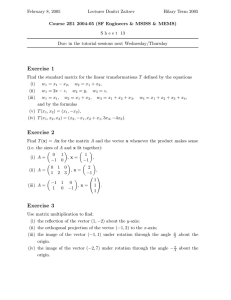
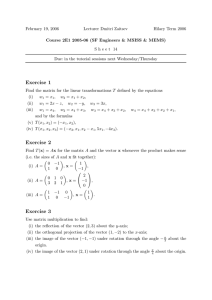
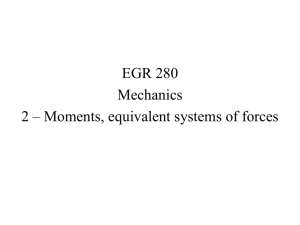
![MA1S12 (Timoney) Tutorial sheet 5b [February 17–21, 2014] Name: Solutions](http://s2.studylib.net/store/data/011008024_1-aff7ce804bc4e58f7a43f1b077bfbe2a-300x300.png)
